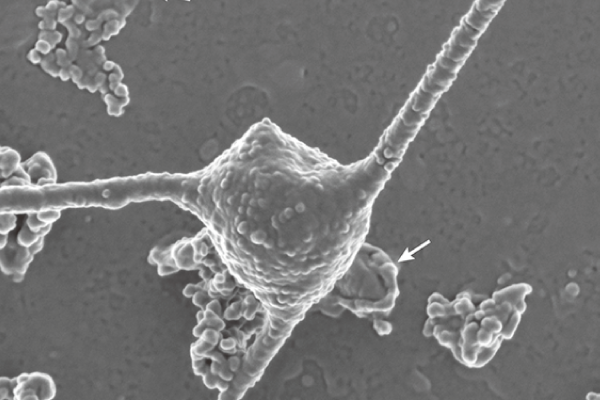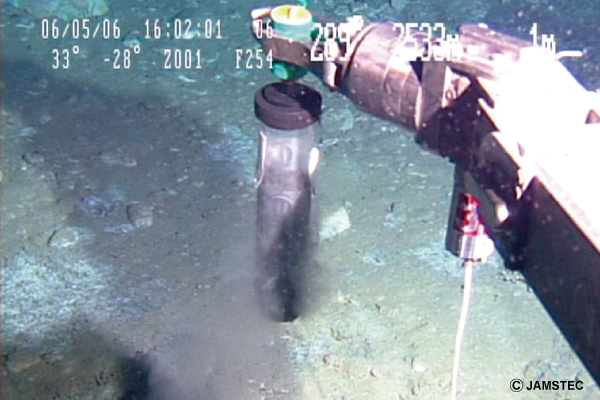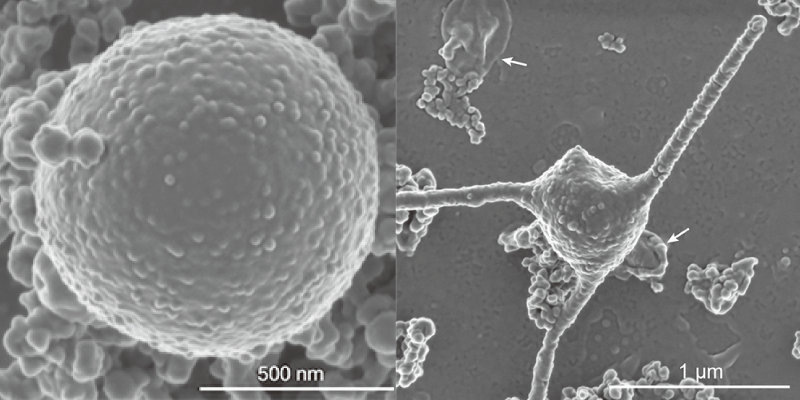- PROJECT MOTHER
- someone
- Information for Middle and High School Researchers
Archaea -Scooped up from the bottom of the deep sea, hints of the birth of eukaryotes
2020.06.17
Senior Researcher, Ultra-Advanced Research Program, Ultra-Advanced Research and Development Division, JAMSTEC
Hiroyuki Imachi Interview with Mr.
Microorganisms are the most abundant living things on earth. The number of microorganisms is estimated to be 1012 species, of which 85 to 99% have not yet been successfully cultured, and their true nature is unknown. One of the places where these mysterious creatures are believed to be hiding in large numbers is actually the seafloor.

Moment when the core sampler of the Shinkai 6500 collects seafloor sediments.
A scoop of mud from the sea bottom
It is believed that many unknown microorganisms live in the sediments that accumulate on the ocean floor. To uncover these mysteries, Hiroyuki Imachi ventured to the bottom of the ocean aboard the manned research submersible Shinkai 6500. He had just arrived at JAMSTEC, and this was his first glimpse of the ocean floor.
The aim of this project is a group of uncultivated microorganisms including methane oxidizing bacteria living in the deep sea. These are microorganisms that decompose methane under anoxic conditions. Prior research had suggested the existence of these microorganisms, but no one knew what they were. In 2006, we gently scooped up the accumulated mud from further down on the seafloor with a core sampler and brought it back to the surface. Our research began with great anticipation.
The decisive factor for successful culture is the sponge?
However, many microorganisms living in the special environment of the deep sea have not been successfully cultured in the laboratory. Cultivation itself, which is the basis of microbial research, is very difficult. Dr. Imachi, who was originally engaged in research on microorganisms related to water treatment in the field of civil engineering, came up with a new method to cultivate deep-sea microorganisms by applying bioreactors used for sewage treatment. The sponges used for this purpose are also found in your kitchen.
In this reactor culture, a sample of muddy water diluted with culture medium is attached to a urethane sponge to provide a habitat for the microorganisms. Methane gas is supplied to the inside of the apparatus to make it as close as possible to the environment of the seafloor from which the samples were taken. In 2018, we finally succeeded in finding the desired microorganisms. Prometheoarchaeum syntrophicum(Prometeoarchaeum syntrophycum) was successfully isolated.

▲ Archaea MK-D1 belonging to the Asgardian group, which is most closely related to eukaryotes
The identity of the veil removed
The microorganism, named strain MK-D1, is only 550 nm in size, with a simple spherical cell interior, but a complex exterior that produces long spines and numerous vesicles. MK-D1 divides slowly, dividing once every 14 to 25 days. Compared to the model organism E. coli, which divides once in 20 minutes, the difference in speed is obvious. The maximum cell density is so low that it is barely visible to the eye, even when fully cultured.
Furthermore, MK-D1 was characterized by its inability to survive without other microorganisms. MK-D1, which prefers an anaerobic environment without oxygen, grows by degrading amino acids to produce hydrogen. However, MK-D1 is a symbiotic bacterium that cannot grow without passing the hydrogen it produces to other microorganisms. Furthermore, MK-D1 needs amino acids and vitamins, which are essential for the production of its own cells, from its symbiotic partner microorganisms to survive.
A Close Look at the Origin of Eukaryotes
Detailed genetic studies of MK-D1 showed that it is an archaic prokaryote most closely related to eukaryotes, and although MK-D1 is an archaic organism, it possesses a large number of genes related to the cytoskeleton and information processing, which have been considered characteristic of eukaryotes. It has long been a mystery whether this microorganism really exists. We have finally found the root of the mystery. How did eukaryotic organisms originate on the earth approximately 2.7 billion years ago? Future research may reveal more about their evolutionary path.
Mr. Imachi says, "I want to reveal the mechanisms of organisms that no one knows about yet. The workings of living creatures still continuing at the bottom of the deep sea, where traces of the ancient earth remain, are sure to reveal discoveries that will greatly shake the previously believed theories of biological evolution.
(Text: Kaori Nakajima)
See also the video!
How we eukaryotes came to be on earth - a new theory of evolution E3Model
Successful cultivation of "Archaea," a microorganism that plays a key role in the birth of eukaryotes
